When Grand Central Terminal opened, some of its most touted amenities included the special waiting rooms for men and women located right next to the general waiting room. Included within were a barbershop, dressing rooms, and a manicure parlor, and all were operated by a rather ingenious entrepreneur by the name of James P. Carey. Not only did Carey have a gift for making and creating businesses, he recognized Grand Central as a prime opportunity, and the perfect place to launch those businesses.
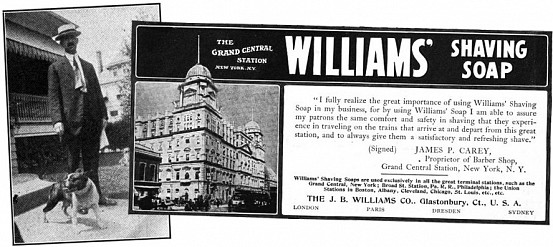
Left: Photograph of James P. Carey with his dog Kerney, Right: Advertisement for Williams’ Shaving Soap, with testimonial by Carey and citing his barber shop in Grand Central Station.
Born in Middletown, Connecticut around 1869, James P. Carey was a trained barber that just happened to have a knack for business. After moving to New York City in his youth, he eventually started a chain of 25 barber shops, which he ultimately sold to focus on business ventures in Grand Central. His first established Grand Central endeavor was a barbershop in 1905 – several years before today’s Terminal was constructed. Like several other businesses in the old station, Carey reestablished his barbershop in the Terminal when it was completed, though it was much expanded.
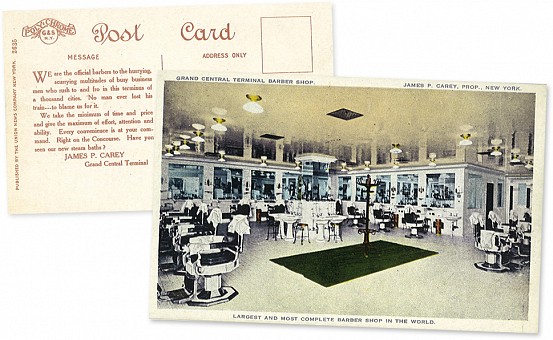
Postcards showing Carey’s barber shop in Grand Central Terminal. From the collection of Steve Swirsky.
Carey’s barbershop in the new Terminal was truly a spectacle, and was claimed to be the largest barbershop in the world. Measuring 10,000 square feet and part of GCT’s mens’ waiting room, it was filled with plate glass mirrors, high polished Carrara glass, cream tiling, and marble basins. Only the best-trained barbers stood at the ready in white uniforms, waiting for patrons. In addition to walk-ins, you could also reserve an appointment by phone, or by telegraph from your train. The shop operated from 6 AM to midnight, and in addition to the barbers employed 2 cashiers, 3 coat and hat attendants, 3 shoe polishers, and 2 podiatrists (or as they were then called, chiropodists). The shop also contained a Russian steam bath, offered at a cost of 50 cents, and large enough to accommodate 33 men. For the women, Carey operated the manicure parlor and hairdresser as part of the women’s waiting room, which employed 6 manicurists and 2 hairdressers.
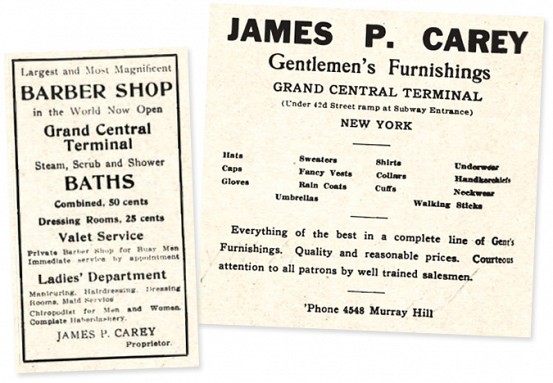
1913 ads for Carey’s businesses in Grand Central Terminal, shortly after opening.
Not only did Carey have a keen business sense, he had quite a talent for sensing what patrons of the Terminal needed. When I posted about the Grand Central Theatre, I tried to make the point that Grand Central morphed along with changing demographic of people that used it, and constantly reinvented itself to remain current and relevant. In that respect, Carey’s inventiveness perfectly reflected that spirit of Grand Central. At first the barber shop tailored to the high profile guests of the Terminal – people that relished their privacy, and could wire the barbershop from their train to reserve a private appointment. Soon after, Carey opened yet another barbershop – a no frills affair geared to the more everyday folks using Grand Central. Not long after that Carey noted that not just passengers were interested in getting their hair cut, thus he opened smaller shop in Grand Central’s office building for employees and train workers.
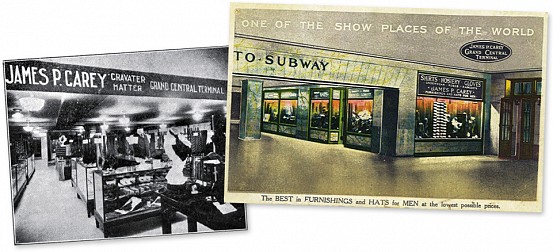
Carey also operated a men’s clothing shop, or as the folks wishing to ooze class would say, a haberdashery. Postcard from the collection of Steve Swirsky.
At most, Carey is said to have operated twelve different businesses in the Terminal, including a clothing shop, laundry, luggage check, and car service. While some people were at first skeptical of the commercial space in the Terminal, calling it “barnlike” and having “storerooms [that were] too scattered,” Carey realized the opportunity, and created new businesses to fill the void. One such business was a haberdashery, or men’s clothing shop, which survived for many years in the Terminal.
Believing that Grand Central represented amazing opportunity, Carey focused on acquiring as much commercial space in the Terminal as possible. In 1920 Carey managed to oust fellow longtime tenant Mendel’s check room and luggage when their lease ran out, acquiring the space for himself. Like Carey, the proprietor of Mendel’s first established his shop in the previous Grand Central, though much earlier than Carey, in the 1870’s. When their lease came up for renewal, the owner, unaware they even had any competition for the space, put in a bid matching what he had been paying previously. Unbeknownst to him, Carey entered a higher bid, and by the time Mendel’s tried to up their bid, it was too late. Knowing that the check room and luggage shop was a necessity for the station, Carey opened his own version in the newly acquired location.
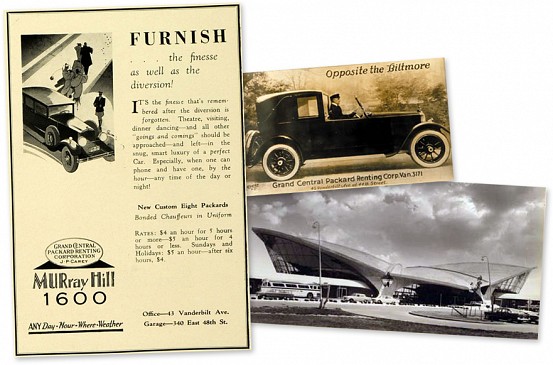
Advertisement and postcard for Carey’s transportation business. Below, right: photo of a Carey bus at JFK airport.
In 1921, right outside the walls of the Terminal, Carey embarked on his most significant and profitable venture – car transportation. Using the fanciest cars available at the time, Carey’s drivers chauffeured wealthy patrons arriving and departing Grand Central Terminal – rumored to include Babe Ruth, John F. Kennedy, and J. Edgar Hoover. Eventually the car service was expanded to include New York’s airports, and buses were added to the fleet. Though the company has gone through many changes and transitions over the years, Carey International is the current form of the company started so many years ago outside Grand Central.
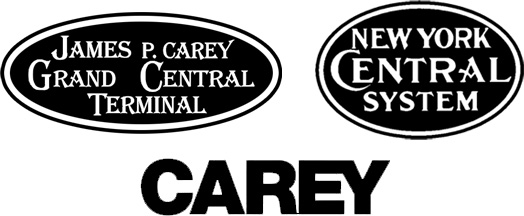
In a move that would likely be frowned upon today, Carey fashioned himself a logo modeled after the New York Central’s. Below is the logo in use by Carey International, the current form of the company that J.P. Carey started many years ago.
Carey operated all of his businesses in the Terminal until 1940, when he retired due to illness (he died not too long after, in 1942). Many of the businesses he set up in the station, like the men’s clothing store, lasted for at least 50 years. The baggage check service was ultimately rendered obsolete when the New York Central installed lockers for travelers. As mentioned above, a successor firm to the transportation service Carey started still exists under the name of Carey International.
One final vestige of the Carey name still exists in the Terminal – a spot called Carey’s Hole (visible in this Metro-North floor plan). Until recently, Carey’s Hole was a locker facility used by Metro-North’s conductors and engineers (these locker facilities have now been relocated to the third floor). Located below the spot where Carey’s barbershop once was, this basement area was likely used for storage many years ago. For a man who spent much of his life on endeavors in Grand Central Terminal, it seems appropriate that at least one spot in the Terminal bears his name – even if it is just a basement.


Another great story! Of course, growing up in the 50s and 60s, I’d seen the Carey buses many times in the mid-town area but never knew anything about their eponymous founder.
Your story made me think of GCT phone center which, if my memory serves, was on the main floor (concourse?) underneath where the Apple store is now. There were dozens of phone booths and a central service desk where you’d give an operator the (long distance?) number you wanted and she’d direct you to a particular booth. Any pictures and the story behind those booths would be greatly appreciated (in the unlikely event you run out of stories about the marvelous GCT).
Can’t say I’ve heard anything about that… are you talking about where the old baggage check was, and later on had a bank? I’ll have to investigate :)
I’m honestly not sure about the actual location. I was just a kid then and it’s been awhile since I’ve been at GCT to re-fresh my memory. I found a few oblique references on some online forums but I’ll continue looking (I have great faith in Google). I remember my father using the service a few times so maybe an older sibling (or my 94-year-old mother!) remembers something.
IIRC, the telephone center was on the east side of the upper level and the baggage room was on the west side.
Emily, you are usually spot-on with everything, so I am loathe to point out an error…but you clearly made one in the caption for the JFK terminal photo. That could not possibly have been taken in 1948, since it shows Eero Saarinen’s wonderful TWA terminal that wasn’t even started until 1956 and opened in 1962. Plus, the Carey bus shown is a “new look” model that wasn’t introduced until 1959.
I’d much rather the info be factually correct! Thanks for that, I’ve updated the caption :)
Great post. I’d be interested in seeing more you might come across on early businesses in the terminal. My grandmother seemed to think a relative of ours owned what might have been the first dry cleaner in GCT in the teens or ’20s, it would be way cool to substantiate it somehow.
That’s my great grandfather. I remember when they closed the haberdashery my siblings and I went to the shop and took anything we wanted. Needed bigger closets!
Awesome to hear from you! Do you recall what year the haberdashery closed? I wasn’t able to definitively figure that out.
Sometime around 1967. It may have been concurrent with the sale of Carey Transportation (the bus line) to Greyhound.
Actually JPCAREY Shop closed around 1971- 1972
Carey Transportation was sold to Greyhound in 1969
Barbershops and package check closed in the mid-1960s
Yeah, I figured it closed sometime in the 70’s – the NY Times obituary for J. Paul in 1973 says he retired from the haberdashery 3 years previous, and that his son J. Paul Jr. is now running it. That seems to imply it was still around even in 73.